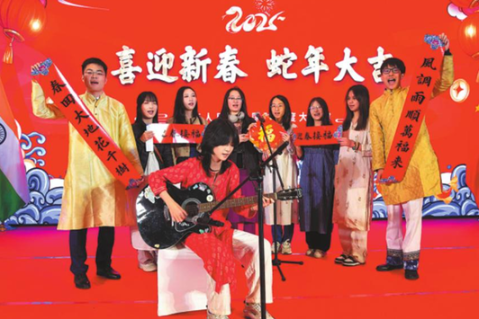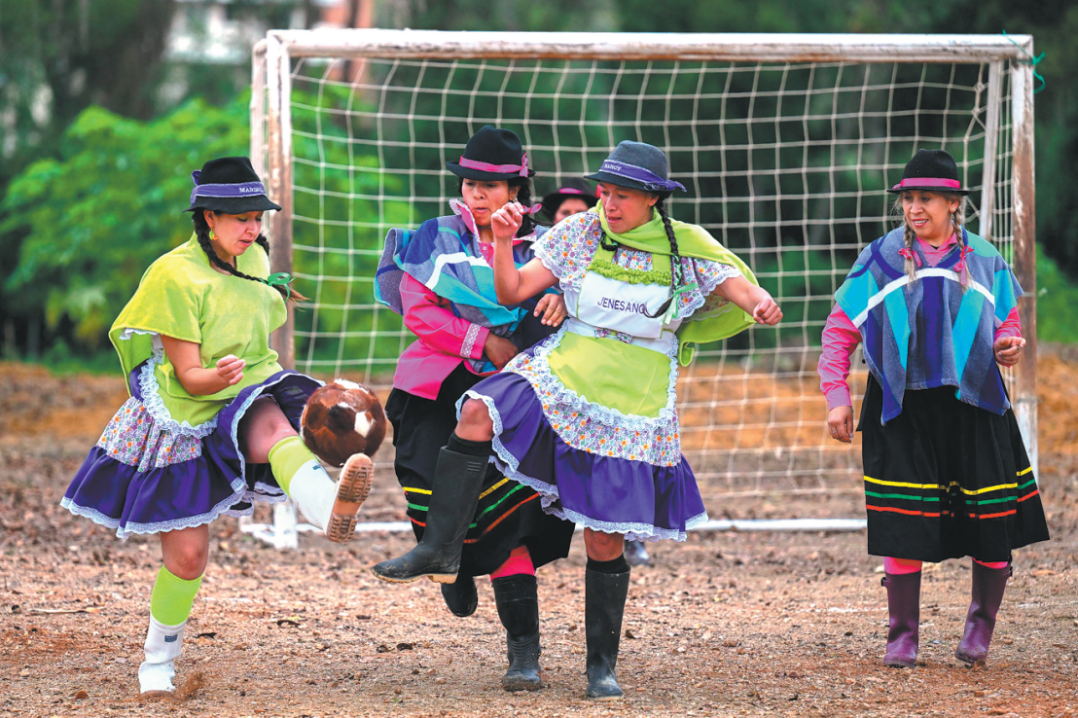Friendship across Himalayas
Language learners forge bonds between two civilizations


Editor's note: In this weekly feature China Daily gives voice to Asia and its people. The stories presented come mainly from the Asia News Network (ANN), of which China Daily is among its 20 leading titles.
In hand with a masala dosa, a crispy South Indian crepe stuffed with spicy potato curry, Chinese youth Yang Rui, 21, began his one-day exploration of India. He boarded the Hyderabad Metro to the English and Foreign Languages University, eager to dive into a culture he could experience outside textbooks.
During a Hindi literature class, Yang eagerly listened and asked questions until an Indian student turned to him and asked, "Does your hometown have Indian culture?"
Yang paused and thought for a moment. Then he began to narrate the legend of the golden-winged bird from his Bai ethnic community in Southwest China's Yunnan province.
He spoke of how, according to folklore, a giant bird crossed the mighty Himalayas and arrived at Erhai Lake in Dali, Yunnan. There, it was woven into the spiritual beliefs and artistic expressions of the Bai people, becoming a symbol of strength and divinity across generations.
Yang said the bird was inspired by Garuda, the mythical bird deity revered across India and much of South and Southeast Asia.
The room filled with curiosity as classmates asked more questions, intrigued by the cultural overlap between China and India.
After talking with his Indian peers and traveling through India, Yang got to know that in Indian city Kochi, Chinese voyager Zheng He had made several stops at the port during the Ming Dynasty (1368-1644), leaving behind records of grand trade exchanges.
This is just a glimpse of Yang's day as an exchange student pursuing Hindi major. Yang is a third-year undergraduate student at Beijing Foreign Studies University.
Like the bird of legend, those who explore deeper into another country's language like Yang, cross the Himalayas carrying friendship between two countries.
Vikash Kumar Singh, an Indian national who is currently a teacher at the School of Asian Studies, Beijing Foreign Studies University, teaches Hindi, as well as Indian literature, culture, and history.
Singh believes that people in India lack an understanding of China, while translation could be an ideal medium for them to learn more about the country. This realization has inspired him to translate Chinese literature into Hindi.
"China and India have shared similar historical experiences and cultural traditions … Both countries have pursued poverty alleviation," he said.
Singh said the two countries have enjoyed a long history of cultural communication, which should be further strengthened.
Singh's first encounter with China occurred in 2004. The extensive economic cooperation between China and India at the time sparked his interest in the language. Singh switched his major from mathematics to Chinese studies at Jawaharlal Nehru University in New Delhi.
"When I started learning Chinese, my primary goal was to secure a good job. However, as I delved deeper into the language, I developed a keen interest in understanding Chinese people, history, and society."
As a language scholar, Singh helped translate a collection of Chinese folk stories. It includes more than 40 widely popular tales — among them The Foolish Old Man Removes the Mountains, which is about a man's unshakable resolve, and The Cowherd and the Weaver Girl, a timeless tale of love.
He also translated Qin Qiang, a novel by Chinese author Jia Pingwa. Singh said rural life in China and India share many similarities. For example, parents favor rustic names because they are thought to keep children safe and easier to raise.
Singh said he knew little about China before coming here. China has changed significantly and become a prosperous country over the past 40 years. "I believe it is my responsibility to tell the truth to my friends," he said.
Promoting understanding
Singh said language is the best way to bridge the gap between the two countries.
Geetanjali Dhar, founder of a Hong Kong-based Hindi-learning platform called Sanskriti, shares this conviction. She said that, contrary to what some might assume, Hindi remains India's most widely spoken language.
Citing India's 2011 census, she noted that 57.1 percent of the population speaks Hindi, compared to 10.6 percent who speak English.
"The children of the Indian diaspora in China that I met were learning Mandarin. And I think a more multicultural world will eventually lead to a better world," Geetanjali said.
"To encourage the cross-cultural dialogue and mutual understanding and deeper appreciation of both cultures … I want to expect that both civilizations can learn each other's language in their script," she said.
In China, over ten universities now offer undergraduate Hindi language program. Still, it's a small number.
Li Yalan, who heads the Hindi program at Beijing Foreign Studies University, said that graduates mainly pursue two career paths: entering multinational companies in both China and India or joining government departments like the Ministry of Foreign Affairs.
After graduation, language learners will contribute to cultural and economic exchanges between China and India, Li said.
The rise of social media has also created new opportunities for cultural exchange.
In recent years, several Chinese vloggers studying language and international relations in India have gained a substantial following. One such individual is Li Zishuo from Sichuan International Studies University.
Through his daily updates from Jawaharlal Nehru University, he has given Chinese audiences a glimpse into life in India — its classrooms, markets. His channel now boasts over 700,000 followers.
He said in his video that Indian and Chinese youths shared high curiosity about each other. Among the young people he met in India, curiosity about China ran high, but understanding remained limited. Most wanted to know one thing: how China developed so quickly.
Li, from Beijing Foreign Studies University, said that even in the globalized age, the two countries still know little about each other. In China, "India" is too often reduced to Bollywood songs and dances. In India, views of China are largely filtered through Western media.
"Language carries more than words," she said. "It isn't just a tool of communication; it carries culture and philosophy. Only by learning the language can you truly understand a country. And once you do, it's easier to see how its people act, speak and think."
"That is why real people-to-people contact can build a true bridge of friendship," she said.
Sang Yihan and Wang Huanran contributed to this story.
Contact the writers at houchenchen@chinadaily.com.cn































